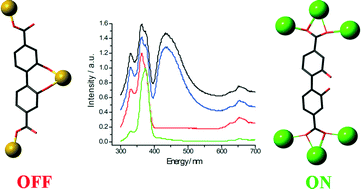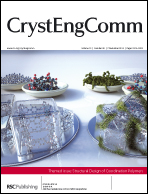Chelation-driven fluorescence deactivation in three alkali earth metal MOFs containing 2,2′-dihydroxybiphenyl-4,4′-dicarboxylate†
Abstract
Three new metal–organic frameworks (MOFs) have been synthesised from alkali earth metal ions of increasing ionic radii (Mg, Ca and Sr) and 2,2′-dihydroxybiphenyl-4,4′-dicarboxylic acid (H4diol). The distinct coordination environments, framework topologies and the non-coordinated diol moieties accessed are a result of using differently sized metal ions for MOF synthesis which affects the ability of the diol moieties to chelate the metal. Detailed structural analysis of [Sr3(H2diol)3(DMF)5], [Ca3.5(Hdiol)(H2diol)2(DMF)5]·1.2DMF and [Mg(H2diol)(DMF)2]·DMF show distinctive variations in variable temperature expansion/contraction properties and porosity. In addition, [Sr3(H2diol)3(DMF)5] and [Ca3.5(Hdiol)(H2diol)2(DMF)5]·1.2DMF display a broad fluorescence emission (λmax = ~435 nm) under ultraviolet light due to the presence of non-coordinated biphenyl-diol moieties within the structures, while chelation of Mg by the diol pocket in [Mg(H2diol)(DMF)2]·DMF leads to quenching of the ligand fluorescence.

- This article is part of the themed collection: Structural Design of Coordination Polymers

 Please wait while we load your content...
Please wait while we load your content...